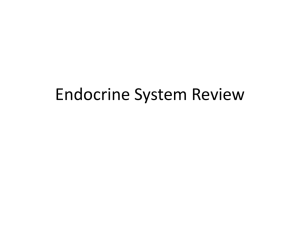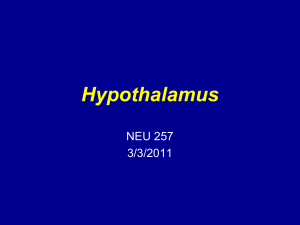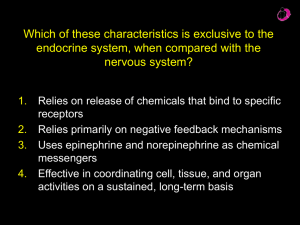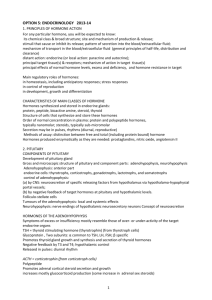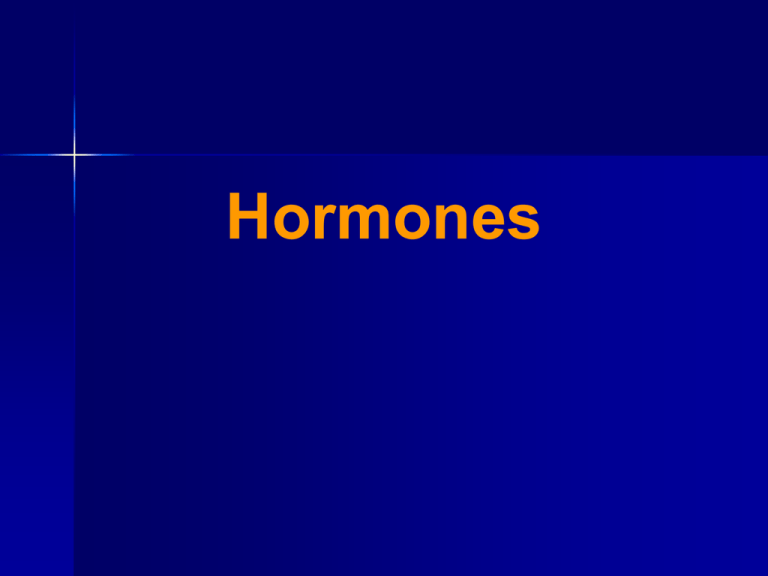
Hormones
Anterior Pituitary:
Growth Hormone (GH)
Stimulates increase in size and mitotic
rate of body cells, increases fat utilization
Hypothalamic growth hormone releasing
hormone (GHRH) stimulates secretion;
Somatostatin (SS) inhibits secretion
Enhances amino acid movement through
membranes and promotes protein synthesis
Promotes long bone growth
Deficiency or absence of
somatotroph cells
Underproduction of
growth hormone
(somatotrophin)
PITUITARY DWARF
Destructive disease of part of anterior
pituitary (usually with damage to
posterior pituitary and/or hypothalamus)
Underproduction of growth and
other endocrine-trophic hormones
FROHLICHS DWARF
(Lorain Dwarf)
Delayed skeletal growth
and retarded sexual
development but alert,
intelligent, well
proportioned child.
Stunting of growth, obesity (large
appetite for sugar); arrested sexual
development; lethargic; somnolent;
mentally subnormal.
Prolactin (PRL)
Sustains milk production after
birth
Secretion stimulated by hypothalamic
prolactin-releasing hormone (PRH)
and inhibited by prolactin-inhibiting
hormone (PIH)
Aids in decreasing LH secretion in men
Thyroid-Stimulating Hormone (TSH) =
Thyrotropin
Controls secretion of hormones from
the thyroid gland
Thyrotropin-releasing hormone (TRH)
from the hypothalamus stimulates
secretion
High levels lead to goiter
Adrenocorticotropic Hormone (ACTH)
Controls secretion of hormones from
the adrenal cortex
Corticotropin-releasing hormone (CRH)
from the hypothalamus stimulates
secretion
Stress can stimulate CRH secretion
Follicle-stimulating Hormone
(FSH)
A glycoprotein caled also a gonadotropin
Gonadotropin-releasing hormone (GnRH) from
the hypothalamus stimulates its secretion
In women, it stimulates the development of
ovarian follicles, stimulates follicular cells to
secrete estrogen
In men, this gonadotropin stimulates growth of
the seminiferous tubules and sperm production
Luteinizing Hormone (LH)
Female gonadotropin LH or male
gonadotropin LH = ICSH
Hypothalamic gonadotropin-releasing hormone
(GnRH) stimulates its secretion
Promotes secretion of sex hormones
(testosterone)
In women, it promotes egg release = ovulation
Posterior Pituitary:
Antidiuretic Hormone (ADH)
Causes kidneys to retain water =
concentrates urine
In high concentration, it raises blood
pressure
Hypothalamus produces and posterior
pituitary neurosecretory cells release ADH
in response to changes in blood volume
and changing blood concentration
Oxytocin (OT)
Contracts muscles in uterine wall and
those associated with milk-secreting
glands
Produced by the hypothalamus and
secreted by neurosecretory cells in the
posterior pituitary in response to uterine
and vaginal wall stretching and
stimulation of breasts
Thyroxine (T4); Triiodothyronine (T3)
Regulate metabolism of carbohydrates, lipids,
and proteins
Essential for growth and development and
maturation of the nervous system
Iodine needed as integral part of molecules
Follicular cells secrete the precursor toT3/T4 which
is without iodine (I) called thyroglobulin; upon
addition of I, thyroglobulin becomes either T3 or T4
which are released into the blood
Cretinism occurs due to neonatal T3/T4
deficiencies and is marked by growth and
maturation disorders (dwarfism, delayed
sexual development, etc.) and central
nervous disorders (intelligence deficits,
seizures, etc.). The administration of thyroid
hormones in the first six months of life can
prevent or reduce some of these
abnormalities.
Calcitonin
Lowers blood calcium levels and
phosphate ion concentration; high blood
calcium
concentration stimulates secretion
Effect on bone matrix: Increases calcium
and phosphate deposition
Effect on kidneys: Increases excretion of
calcium and phosphate ions
Parathyroid Gland
Four small glands
found on the
posterior surface of
the thyroid gland
Secrete parathyroid
hormone (PTH) or
parathormone, a
protein hormone
PTH increases blood
calcium concentration
and phosphate
concentration by
bone resorption
Parathyroid Hormone (PTH)
Stimulates bone resorption by osteoclasts
and osteocytes
Inhibits activity of osteoblasts
Effect on kidneys: Causes kidneys to
conserve calcium and excrete phosphate
Effect on intestine: Stimulates calcium
absorption through vitamin D
Low blood calcium concentrations stimulate
secretion of PTH from the parathyroid gland
Adrenal Gland
It is an endocrine gland that is located in the abdomen
superior to the kidney.
Under conditions of fear or stress, a surge of the hormone
adrenaline mobilizes the body for peak physical response.
Flooding the bloodstream at up to 300 times the normal
concentration, the adrenaline interacts with receptors on
cells in various organs, increasing the heart rate and
blood pressure and prompting the release from the liver of
extra sugar to fuel muscular work. Taken together, these
reactions constitute a "fight or flight" response.
In the medulla, specialized cells known as chromaffin cells
manufacture, store, and secrete a complex mixture of
hormones, the most important of which is adrenaline.
The adrenal medulla can also be thought of, however, as part
of the sympathetic nervous system, which helps to regulate
such involuntary functions as heart rate, intestinal movements
and the dilation of the pupil.
The adrenal medulla is controlled by nerves originating in the
spinal cord; its primary hormone, adrenaline, is closely related
to noradrenaline, the characteristic neurotransmitter of the
sympathetic nerves. Moreover, the adrenal medulla itself
secretes noradrenaline and neurologically active substances
known as neuropeptides.








